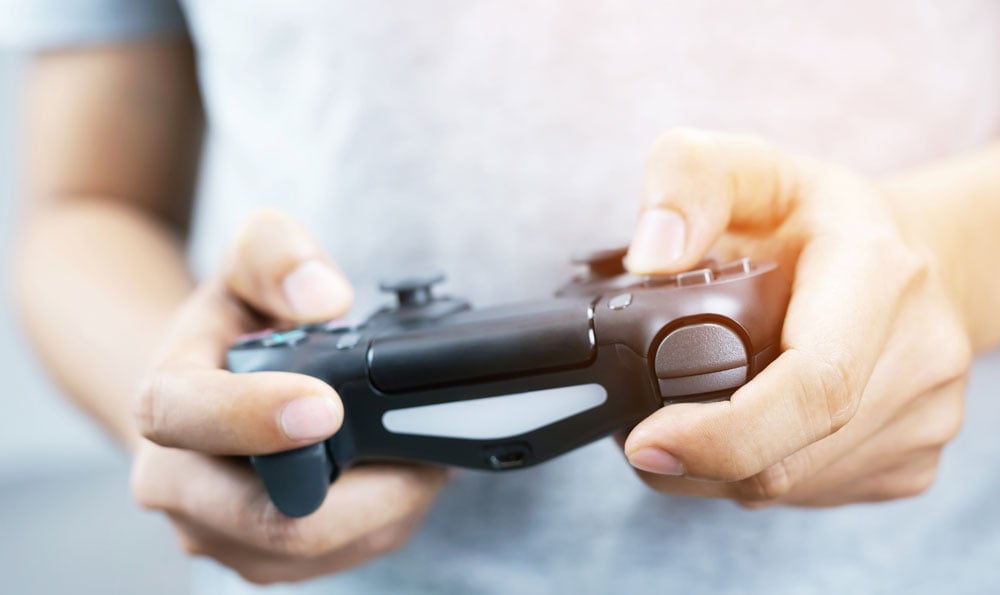
The gaming industry now rakes in more revenue than sports and movies combined, and its growth shows no sign of wavering. But growth hinges on the industry's ability to adapt. So what will the next-generation gaming experience look like? It comes down to three words: amazing user experience.
Augmented reality, cross-platform gaming, machine learning AI, hi-fi graphics, and the metaverse are all solutions used to enhance user experience. It’s through these advancements that the gaming industry continues to rocket upward.
Mobile gaming is the fastest-growing sector in the gaming industry. Booming revenues can be attributed partly to technological advancements and the continued adoption of smartphones, especially among younger crowds. They're also due to developers creating multi-platform games where users can enjoy seamless gaming experiences across their devices.
Below we’ll explore how smartphone gaming manufacturers and engineers are incorporating revolutionary new gaming controls and capitalizing on cross-device platforming to amplify mobile gaming experiences.
The Growing Influence of Mobile Gaming

A 2020 study found that users increased their mobile game hours by 35% from 2019 to 2020, and the numbers continue to grow. From 2021 to 2022, mobile gaming industry revenues grew by $12.8 billion. Now, experts and analysts debate whether mobile gaming will someday make consoles obsolete. Whichever way it goes, mobile gaming growth is clearly more than a fad.
Gaming on smartphones, tablets, and devices like Nintendo Switches has caught on for multiple reasons:
- Accessibility: Mobile devices make gaming possible wherever and allow users to connect with friends anytime. Likewise, cross-platform gaming increases the selection of games available for download on mobile app stores.
- Cost-Effectiveness: Mobile games are cheaper and more widely consumed than console games, meaning game developers have a financial incentive to create high-quality products for mobile interfaces. Also, digital products are cheaper for mobile users, leading to more purchases.
- Tech Advancements: Games like Pokémon GO use developments in augmented reality to provide it on a mass scale. Other elements such as faster processing, 3D scene video game design, deep learning, and better visual quality cause more gamers to consider switching from their console and monitor to their phone.
- Sociability: Gamers of all ages continue finding camaraderie through video games and online environments. Mobile devices increase the social element by allowing friends to easily group up to play in person or meet new people to connect with online.
With these strengths, mobile gaming continues to assert its influence as the largest sector within the gaming world. Expectations for the expansion of mobile gaming are huge, as the market reached $95 billion in 2022 and is projected to reach $140 billion by 2026.
Challenges With Smartphone Gaming Controls and Experience
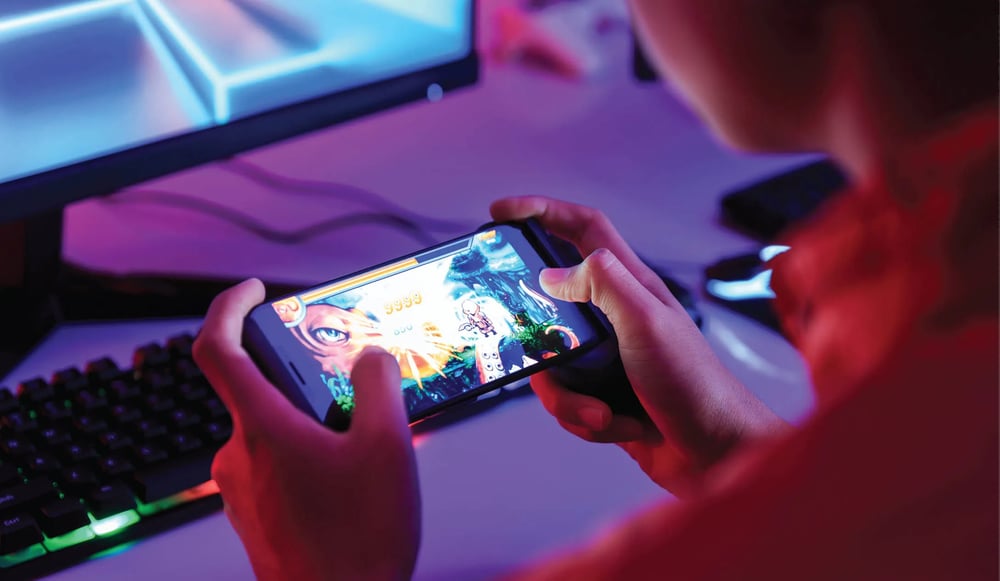
Mobile gaming is skyrocketing, but it’s not without roadblocks. A few major issues still hinder developers from providing experiences as immersive as console gaming.
The Need for Optimal Gaming Controls on Mobile
Mobile device gamers face a couple of major limitations. Screen size is an obvious one. A lack of optimal controls also gets in the way of the mobile gaming experience. For example, console gamers have a dedicated controller where each button is programmable for users to fashion a unique gaming experience. This is accomplished through extensive software settings and haptic motors that create a feedback response to immerse users in gaming environments.
Mobile controls lack the robust, rapid feedback mechanisms that console gamers are accustomed to. Many phones use haptic elements within touchscreens, but the output usually isn't as diverse and effective as that of console controllers, specifically for gaming. Insufficient programmability is another issue, as most phones have preprogrammed and limited haptic sensors that only trigger in specific scenarios.
Ergonomics and Mobile Gaming
Gaming ergonomics is another major challenge for mobile gaming designers. Console setups give users the freedom to fine-tune their environments for comfort. Mobile games, however, are severely limited. Using a phone as a controller causes difficulties because it isn't ergonomically shaped for human hands like a console controller is. For example, the PlayStation controller features an L/R trigger and bumper buttons, which improve usability, gaming performance, and intuitiveness. Unfortunately, smartphones are not yet equipped with the technology that allows for a similar button layout.
Certain mobile virtual products, such as the Nintendo Switch, seek to address this challenge by providing a more ergonomic interface. Still, those who use their smartphones struggle to find comfortable setups when playing for long periods.
Tactile and force feedback is another essential part of an ergonomic gameplay environment. Feedback mechanisms increase user satisfaction and provide a more enjoyable and higher-performance experience for long gaming sessions. Unfortunately, most mobile games and devices don't provide a satisfactory level of haptic feedback.
Enhance Gaming Controls for a Superior Experience and Grow Your Business
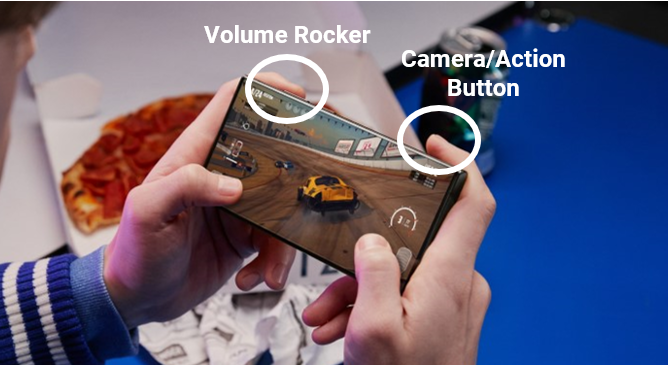
These challenges continue to affect mobile gaming, but change is right around the corner.
Boreas Technologies is introducing a revolutionary Gaming UX Pro mobile button solution that redefines what’s possible for mobile gaming controls. Our new action buttons incorporate localized piezo haptics, gesture detection, and side-by-side buttons, replicating the PlayStation shoulder controller experience.
The Gaming UX Pro button layout uses the volume rocker and camera/action buttons for an ergonomic and gaming-friendly design. Thanks to piezoelectric components, this allows users to use mobile devices with more control, better usability, lower latency, and a premium feel.
Piezoelectric drivers power haptics and feedback response systems through sensors that communicate directly with users during mobile gaming sessions. Major tech manufacturers continue flocking to piezo solutions as a premier option to amplify UX in smartphone gaming buttons, laptop trackpads, and console controllers. Like mobile gaming, piezo technology is more than a trend. Increasingly, the world's leading tech manufacturers look to stay on top by installing piezo controls into their devices.
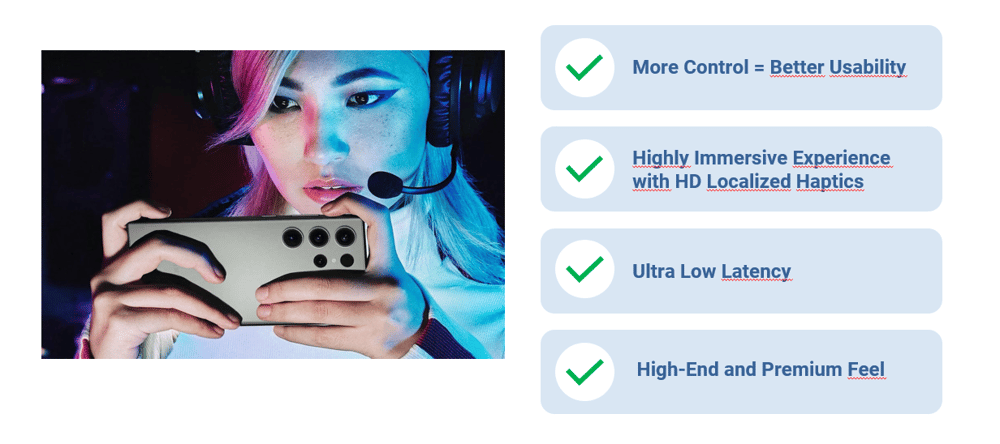
There are several reasons for this. First, piezo-haptics enhance UX by creating a more responsive, immersive, and customizable experience. Many piezo solutions give users access to companion software to alter controls and responses according to force-sensing preferences and specific gesture detection.
Piezo-haptics also take up much less device space, provide quicker responses, and consume much less power than competing haptic solutions. The tech is highly scalable, too, allowing manufacturers to produce a range of sizes and form factors.
Boreas Technologies offers some of the most cutting-edge haptic solutions on the market. With robust programmability, users control button mapping and interactive touch zones with force-sense capabilities. Our products lead the pack in technological capability, and companies have partnered with Boreas Technologies as they rethink their approach to optimizing controls and the future of their user interface.
Visit our website for contact information and to learn how Boreas Technologies can provide the next generation of UX for your products.


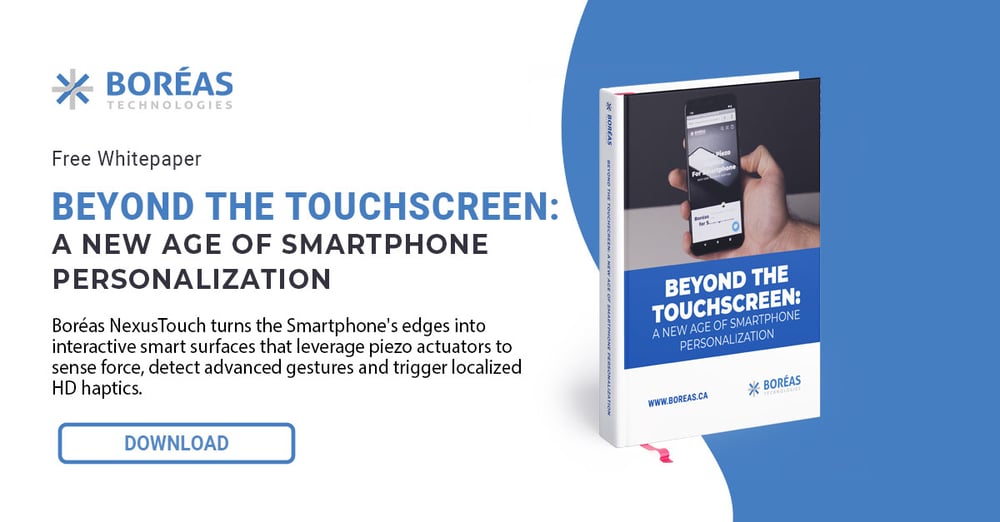
Leave a comment